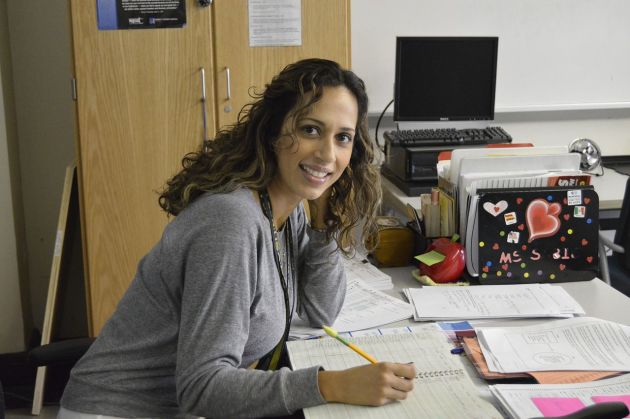There are tons of benefits to learning another language! And, students can reap benefits even if they do not become fluent in the new language. However, there are also very real barriers that lower the probability of students learning another language.

Benefits:
- Increase outcomes in all subject areas: The study of a second language can improve proficiency in the students’ native language. American students taking a foreign language show improvement in English grammar and vocabulary. Multiple studies show that students learning a foreign language show more significant gains on state assessments in various subject areas than their non language learning peers. These gains are present even when controlling for race, gender, and socioeconomic status. So encouraging language learning can have widespread positive benefits for student achievement outcomes which can spread into other subject areas, including math.
Further Information:
- Recent Dissertation on 2nd language acquisition benefits
- Past research on 2nd language acquisition benefits
2. Learning another language also has cognitive benefits: Studies show that students  who are learning another language are better at remembering lists or sequences, which could be attributed to how students learn grammar rules and structure in the TL. Language students are also more resistant to framing and conditioning techniques when watching things like television ads and political speeches in another language because they are more emotionally detached. Meaning that when students don’t hear and see media in their native language, they are less likely to let their emotions get in the way of deductive and critical thinking skills. Most importantly, second language acquisition can stave off the kinds of cognitive declines that can lead to diseases like dementia and Alzheimer’s, even if the person isn’t fluent in the TL. It has also been shown that if bilinguals do contract dementia and Alzheimer’s that it’s later in life than their monolingual peers.
who are learning another language are better at remembering lists or sequences, which could be attributed to how students learn grammar rules and structure in the TL. Language students are also more resistant to framing and conditioning techniques when watching things like television ads and political speeches in another language because they are more emotionally detached. Meaning that when students don’t hear and see media in their native language, they are less likely to let their emotions get in the way of deductive and critical thinking skills. Most importantly, second language acquisition can stave off the kinds of cognitive declines that can lead to diseases like dementia and Alzheimer’s, even if the person isn’t fluent in the TL. It has also been shown that if bilinguals do contract dementia and Alzheimer’s that it’s later in life than their monolingual peers.
Further Information on Cognitive Benefits:
3. Understand the literature, music, and digital media of a language in its original form: Often the nuance, style, and tone of a song, a book, or a film gets lost in translation. There are cultu ral references and elements of many languages that can’t be translated, which is something I didn’t really appreciate until I started learning Japanese. For example, I learned to pay attention to names in Japanese media including TV shows, movies, and manga (comics), because they can carry symbolic meaning. In fact, it’s very common for actors/characters within the aforementioned mediums to ask
ral references and elements of many languages that can’t be translated, which is something I didn’t really appreciate until I started learning Japanese. For example, I learned to pay attention to names in Japanese media including TV shows, movies, and manga (comics), because they can carry symbolic meaning. In fact, it’s very common for actors/characters within the aforementioned mediums to ask
someone for the Kanji (Chinese characters) used in their names. For example, in the animated movie “Wolf Children” the mother names her children “Ame” and “Yuki”. A person seeing the childrens’ names in the Roman alphabet misses the fact that the mother used the characters for Rain (雨; Ame) and Snow ( 雪; Yuki). And if you miss that reference you’ll miss the subsequent metaphors and symbolism weaved throughout the rest of the movie connecting the events of the story to the characters names. Thus being able to listen, read or watch something in the TL enables the consumer to have a deeper understanding and appreciation of it.
4. Increase Global Awareness and Understanding: Learning another language facilitates cross-cultural understanding and exposes students to diverse perspectives. Foreign language learning can also make students examine and question their own beliefs and assumptions. For instance, in the U.S. we don’t learn too much about East Asia except within the context of WWII and the Korean War. Because of that, the majority of students and Americans in general, don’t question the assumption that Japan has a completely homogeneous population. A sizable part of the Japanese population has mixed ancestry. People also don’t realize that the islands of Hokkaido and Okinawa have indigenous populations. The Ainu are the indigenous indian people that inhabited Hokkaido and the Okinawans had their own kingdom, before Japan acquired them. Okinawans and people with Ainu ancestry still cook traditional foods and celebrate their own traditions to this day.
Barriers:

- Opportunity (i.e. funding, location, and qualified teachers): Today, less than 1% of Americans can speak the language they studied in a U.S. classroom. That statistic is even more troublesome when you realize that in 2008 about 93% of American high schools had foreign language programs. Unfortunately, when state and government officials are deciding what to cut from the budget, foreign language programs are often a victim. According to a 2008 survey from the Department of Education, only 15% of public elementary schools offered language programs, which is down 24% from the previous decade. And if you live in a rural or urban area you’re 3 times less likely to have foreign language programs than private schools. Then there is a lack of qualified, engaging, bilingual teachers. The schools that are capable of expanding or improving their language programs can’t because the the pool of teachers is so small. It’s hard to have more qualified, bilingual teachers when most students don’t become competent in the language they studied in school to then later go into the teaching profession.
Further Information:
 Inefficiency: One big problem contributing to the U.S.’s foreign language deficit is inefficiency. The current structure of the classroom forces teachers to spend the large majority of class time on rote drilling, grammar and vocabulary practice instead of the authentic communication practice necessary to become competent in the TL. Of course students need a good foundation of vocabulary and grammar to build on, but what if we could cut or eliminate the time spent on drilling in the classroom so that we could spend more time on reading, writing, listening, and speaking in the TL? Three language teachers got together and pondered this problem last year. They came up with the web application tool, Classtracks. Our first goal is to tackle the issue of vocabulary practice in class. With ClassTracks teachers can assign vocabulary and assessments for homework, instead of taking up precious class time. We’ve made our tool customizable, adaptable, and personalized; additionally, we give both the student and teacher rich data to track progress. We have started our beta launch and would love feedback or suggestions.
Inefficiency: One big problem contributing to the U.S.’s foreign language deficit is inefficiency. The current structure of the classroom forces teachers to spend the large majority of class time on rote drilling, grammar and vocabulary practice instead of the authentic communication practice necessary to become competent in the TL. Of course students need a good foundation of vocabulary and grammar to build on, but what if we could cut or eliminate the time spent on drilling in the classroom so that we could spend more time on reading, writing, listening, and speaking in the TL? Three language teachers got together and pondered this problem last year. They came up with the web application tool, Classtracks. Our first goal is to tackle the issue of vocabulary practice in class. With ClassTracks teachers can assign vocabulary and assessments for homework, instead of taking up precious class time. We’ve made our tool customizable, adaptable, and personalized; additionally, we give both the student and teacher rich data to track progress. We have started our beta launch and would love feedback or suggestions.


 A 2011
A 2011  students. After testing university students learning foreign language vocab, it turned out that using long term spacing between tests accompanied with feedback profoundly optimized learning. The gains in vocabulary retention were present even when substantial spacing resulted in students making more errors. In other words, trying to minimize errors by having shorter repetition intervals is not as effective as extremely long spaced intervals with feedback.
students. After testing university students learning foreign language vocab, it turned out that using long term spacing between tests accompanied with feedback profoundly optimized learning. The gains in vocabulary retention were present even when substantial spacing resulted in students making more errors. In other words, trying to minimize errors by having shorter repetition intervals is not as effective as extremely long spaced intervals with feedback. Now any teacher knows how invaluable SR is for the classroom. But the question becomes what is the most effective way to incorporate technology in the classroom while keeping the benefits of spaced repetition in mind? A 2010
Now any teacher knows how invaluable SR is for the classroom. But the question becomes what is the most effective way to incorporate technology in the classroom while keeping the benefits of spaced repetition in mind? A 2010  There are numerous flashcard-based SRS that currently exist on the market. However, most of the spaced repetition software on the market are not fully customizable for teachers while being highly adaptive for students, nor do all of them provide important actionable data for both the teacher and students. Here at ClassTracks, we are passionate ambassadors of spaced repetition learning. Our flashcard-based software application offers to bridge this glaring gap between available customizable features for teachers and the highly adaptive features for students. As we keep our eye out on new research findings on blended learning tools, we are excited to be part of this growing SRS space within education technology. To learn more about ClassTracks, please visit us
There are numerous flashcard-based SRS that currently exist on the market. However, most of the spaced repetition software on the market are not fully customizable for teachers while being highly adaptive for students, nor do all of them provide important actionable data for both the teacher and students. Here at ClassTracks, we are passionate ambassadors of spaced repetition learning. Our flashcard-based software application offers to bridge this glaring gap between available customizable features for teachers and the highly adaptive features for students. As we keep our eye out on new research findings on blended learning tools, we are excited to be part of this growing SRS space within education technology. To learn more about ClassTracks, please visit us 

 ral references and elements of many languages that can’t be translated, which is something I didn’t really appreciate until I started learning Japanese. For example, I learned to pay attention to
ral references and elements of many languages that can’t be translated, which is something I didn’t really appreciate until I started learning Japanese. For example, I learned to pay attention to 
